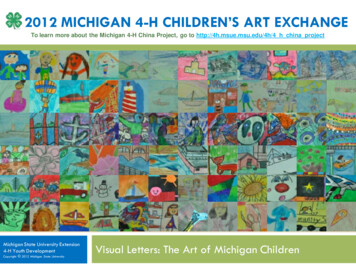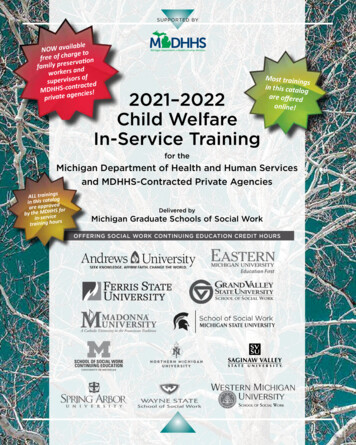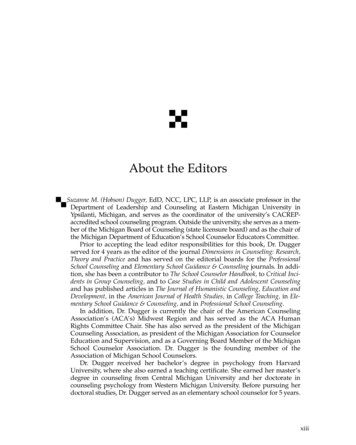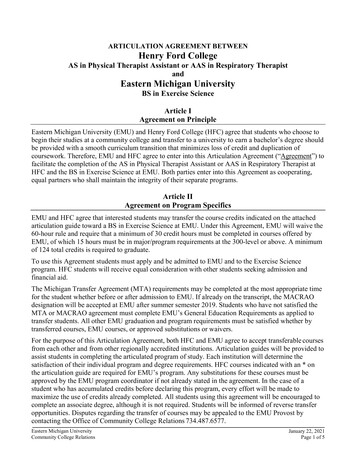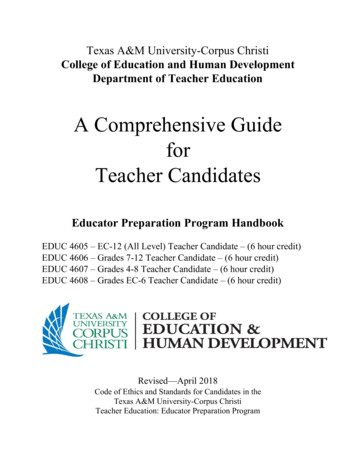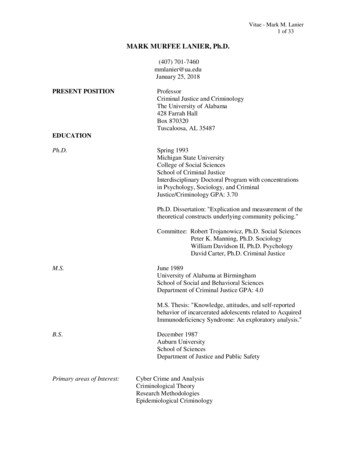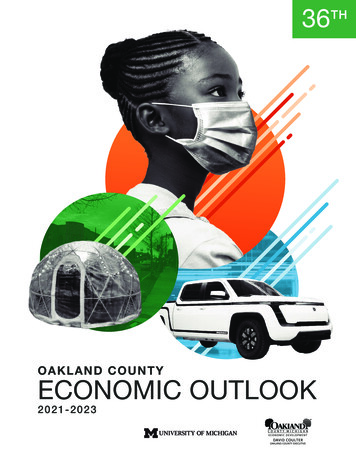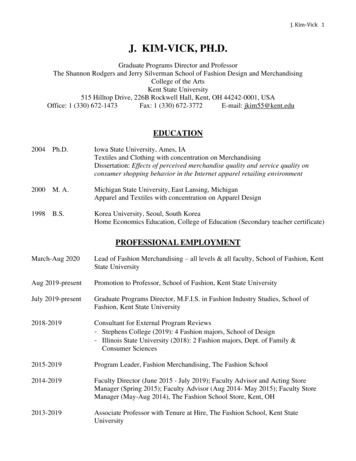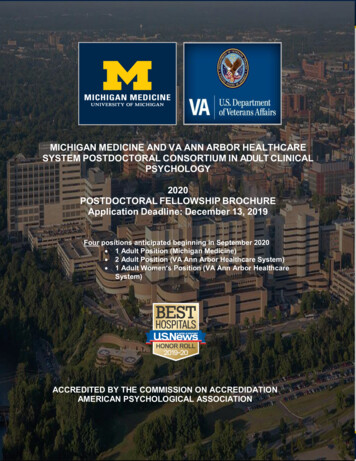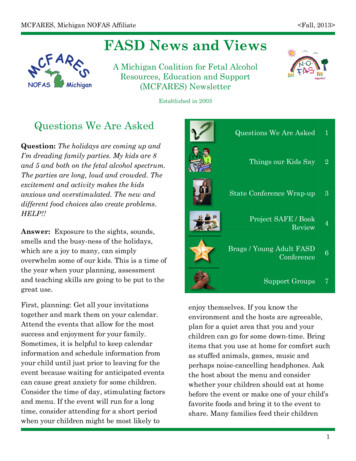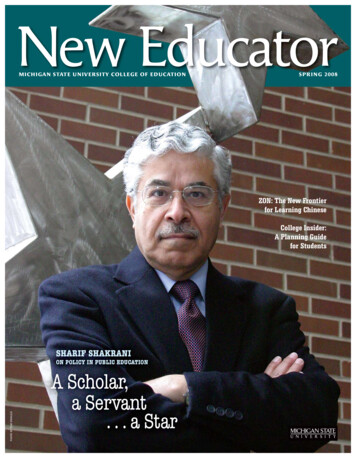
Transcription
New EducatorMICHIGAN STATE UNIVERSITY COLLEGE OF EDUCATIONSPRIN G 2 0 0 8ZON: The New Frontierfor Learning ChineseCollege Insider:A Planning Guidefor StudentsSHARIF SHAKRANIPHOTO BY TOM STANULISON POLICY IN PUBLIC EDUCATIONA Scholar,a Servant. . . a Star
new educatorv o l. 1 3 n o. 2 s p r i n g 2 008The New Educator is published twice a year by theOffice of the Dean, College of Education, MichiganState University, for the faculty, students, staff,alumni and friends of the college.We welcome your comments and news items. Pleaseaddress your letters to: New Educator, College ofEducation, Michigan State University, 518 EricksonHall, East Lansing, Michigan 48824-1034 or tongeary@msu.edu.Visit us on the Web at www.educ.msu.edu/College of Education Alumni Associationwww.educ.msu.edu/alumni/deanCarole Amespresident, college of education alumni associationKathryn Rodgersmanaging editorNicole GearywritersAndy Henion, Kristen Parker, Susan Pettit RileyphotographyTom Stanulislayout/designCharlie Sharp, Sharp Des!gns, Inc.printing/bindingMillbrook Printing, Grand Ledge, MIon the coverProfessor Sharif Shakrani, co-director of theEducation Policy Center at Michigan StateUniversity, poses beside Perpetual Encore, asteel structure by artist Johnny Blue insideWharton Center.PHOTO BY TOM STANULISMSU is an affirmative-action, equal-opportunity employer.new educ ator
F E AT U R E S10OUT OF THE CLASSROOMStudents get on-campus optionto live with, study American SignLanguage16A STEADY VOICEMeet the scholar and “diplomaticmathematician” who leads theEducation Policy Center24TEACHER-INITIATEDTRANSFORMATIONProfessor, student help localcommunity break throughbarriers with Chinese family32ON POLICYThe small-school movement:Shakrani examines the meritsfor Michigan and beyond46LEARNING TO IMPROVISESherry uses case-basedinstruction to prepare teachersfor real classrooms48GLOBAL EDUCATORS IN CHINAIntern, alumna experience lifeas educators in another part ofthe worldS E C T I O N Sspring 2008PHOTO BY SUE NT1
with this issue of the New Educa tor, we are approaching the end of the2007–08 academic year and celebrat ing the arrival of spring. As we lookback, we take stock of a very busyand exciting year for the college, withfaculty engaged in searches for newcolleagues, preparations for a reviewof our teacher preparation programby the Teacher Education Accredita tion Council (teac), dynamic researchprograms, new opportunities abroad,policy debates about education issues,and panels, task forces and commit tees at the state and national levels.Over the past year, this college—already with a long-standing his tory of international research andengagement—has taken further stepsto internationalize its curriculum andprograms. Our goal is to offer ourstudents a range of opportunities thatwill help them develop the kind ofcompetencies necessary for teaching,conducting research and workingwithin a global society. The challengeis daunting, but among the questionswe have been studying are: What doesit mean to be globally competent, howdo we embed globalization through out our curriculum and how cantechnology enable global engagementand learning.We already have several outcomesto report, but only enough space hereto share a few. Starting this next aca demic year, we are launching a GlobalEducators Cohort Program that will beanother special strand in our teacherpreparation program. Similar to theUrban Educators Cohort Program,students will be admitted as fresh men and participate in a specializedcurriculum and set of experiencesdesigned to help them develop intoteachers who can bring an interna tional perspective to the k–12 curricu lum and their own students’ learningexperiences. Kristin Janka Millar andJack Schwille have already begun thework to bring global perspectives tocollege teaching and local k–12 schoolswith funding from the LongviewFoundation.Through the U.S.-China Center andthe Confucius Institute, the collegecontinues to expand its global reachto China. The Confucius Institute atMSU was selected from among the210 institutes existing worldwide toreceive a 2007 Confucius Institute ofthe Year award. Under the directionof University Distinguished ProfessorYong Zhao, our Confucius Instituteis the only one offering Chinese lan guage courses online, reaching moreWhy should we reminisce?Recently, I reflected on my sixdecades of life in East Lansing nextto the campus of Michigan StateUniversity. I remembered hearingthe Spartan Marching Band from thescreened porch, going to the cowbarns, seeing construction of thelibrary addition, wandering the Bealgardens, playing at Cowles House andmore. These contemplations broughtforth images of the ever-changing andevolving university across the streetfrom my home. I have watched boththe city and the campus grow in amyriad of different ways. Throughthe eyes of a youngster with familyengaged in campus vocations, as astudent in the College of Education,as a parent of MSU students and nowin my capacity as president of the Col lege of Education Alumni AssociationBoard of Directors, it has been myfortune to watch this college becomemore and more far-reaching. Thiscollege has seen the best of the triedand true merge with the exciting newpractices of today. The combinationhas fostered a dynamic world-classcollege in an increasingly complexglobal environment.I believe it was 1958 when mygrandfather took me for a ridethrough campus to see the newly con structed College of Education build ing with the Kiva that captured myattention with its unique round look.My first step inside Erickson Hall wasas a teenager when a professor offereda seminar in leadership to our highschool student council. As a student inthe 1960s, I learned about the drive toexpand the college’s efforts in the areaof international outreach. The studentpopulation of the college was becom ing increasingly diverse and the scopeof innovative programs widened.With great pride, I now see a collegewith its eyes toward global education,promoting international interestswith greater offerings and depth. TheMS U COLLEGE OF EDUCAT I O Nfrom the Dean2new educ ator
College of Education is leading inso many facets of education. It is anexciting time.The alumni board’s mission is tofacilitate and support the interests ofthe college and, of course, our alumni.Please consider letting us know aboutyour current pursuits or those of fel low college alumni. We take pride inhighlighting your accomplishments.Your support of the collegethrough membership in the MichiganState University Alumni Associationis a vital part of its success. I hope youwill consider joining or renewing yourmembership as the College of Education reaches further around the world,spring 2008alization” (ed-web3.educ.msu.edu/inter national) for more information aboutthese and other initiatives.This year also has proved to bevery lively in the education policyarena, from debates about the successand future of No Child Left Behindto reports about lagging U.S. studentachievement, especially in mathemat ics when compared to other countries.In this issue (page 16), you will meetSharif Shakrani, who is co-director ofthe Education Policy Center locatedin the College of Education at MSU.Sharif most recently was deputyexecutive director of the NationalAssessment Governing Board, whichhas oversight of the National Assess ment of Educational Progress (naep).He joined the College of Educationfaculty in fall 2005 and brings a wealthof experience and expertise in assess ment and student achievement. Sharifis a prominent contributor to stateand national policy debates; he’s aninvaluable resource to educationalleaders and policymakers as well as toour own graduate students.Finally, I would like to bring yourattention to a new online guide forcollege preparation (page 20) devel oped by Matthew Diemer, assistantprofessor of school counseling. Manyhigh school students have limited un derstanding of the process, require ments or even opportunities relatedto college applications and financialaid. This practical tool is intended toserve as a resource for students andparents navigating college-relatedchoices.It is our goal, through this maga zine, to provide many examples ofhow the college is making an impactthrough the exceptional research,outreach and teaching of its faculty.We strive to make bold moves and stayon the cutting edge—making a differ ence throughout k–16 education. Wewelcome your input and feedback andthank you for your continued supportand interest.Carole AmesPHOTO OF CAROLE AMES BY KIM KAUFFMANthan 2,000 k–12 students and adults.Zhao and his team have launched anexciting new video game called zon/New Chengo that has the potential ofreaching a much larger audience oftech-savvy learners online—especiallysurrounding this summer’s BeijingOlympics (see page 14). Respondingto the increasing demand for teachersof Chinese language, the college willoffer a new certification program forteaching Chinese as a foreign lan guage. It will be available for Ameri can students as well as teachers fromChina.As part of our statewide outreachefforts, the college hosted the secondannual Internationalizing MichiganEducation Conference in April. Thisconference attracts more than 200educators from around the state aswell as representatives from inter national partner schools. We also aredeveloping new and more expansiveopportunities for study abroad, studytrips and exchanges for faculty andstudents. I encourage you to visit thecollege’s Web site under “Internation C O E ALU MNI ASSO C I AT I O Nfrom the Presidentenhancing aspects of education on aglobal level. You could contribute byserving on the board or volunteeringfor events sponsored by the college. Iencourage you to review the Web siteto find a place for your talents.I suppose reminiscing about thepast allows us to mark the notableprogress that has taken place and thegreat strides that are in the works.Let’s reminisce together. See you atHomecoming!Kathryn RodgersClass of 1970 and 19743
High Flying forth Year!a14ELEMENTARY EDUCATION5 University of Illinois–Urbana-Champaign1 Michigan State University6 Ohio State University2 University of Wisconsin–Madison7 University of Michigan–Ann Arbor3 Teachers College, Columbia University (NY)8 University of GeorgiaUniversity of Georgia5 Vanderbilt University (Peabody) (TN)9 Indiana University–Bloomington0 Vanderbilt University (Peabody) (TN)6 Ohio State University7 Indiana University–BloomingtonUniversity of Virginia (Curry)for the 14th consecutive year,both elementary and secondaryeducation, according to the U.S.1 University of Michigan–Ann Arbor9 University of Michigan–Ann Arbor2 Pennsylvania State University–University Park0 University of Illinois–Urbana-Champaign3 University of California–Los AngelesSECONDARY EDUCATION5 University of Southern California (Rossier)1 Michigan State University6 Indiana University–Bloomington2 University of Wisconsin–Madison7 University of Georgia3 Stanford University (CA)8 Vanderbilt University (Peabody) (TN)4 University of Georgia9 University of Pennsylvania5 University of Virginia (Curry)0 Harvard University (MA)4 Michigan State UniversityMichigan State University has thenation’s top graduate programs inHIGHER EDUCATION ADMINISTRATION6 University of Michigan–Ann ArborUniversity of Maryland–College ParkNews & World Report’s 2009 edi 7 Ohio State Universitytion of “America’s Best Graduate9 University of Illinois–Urbana-Champaign1 University of Wisconsin–Madison0 University of California–Berkeley2 Stanford University (CA)Teachers College, Columbia University (NY)Schools.” Rehabilitation counselingVanderbilt University (Peabody) (TN)EDUCATIONAL PSYCHOLOGY3 University of Michigan–Ann Arbor4 University of Illinois–Urbana-Champaignalso kept its No. 1 spot, among atotal of seven College of Educationspecialty areas ranking in the top-REHABILITATION COUNSELING*5 Michigan State University1 Michigan State University6 University of California–BerkeleyUniversity of Wisconsin–Madison8 University of Minnesota–Twin Cities4 University of Iowa9 University of California–Los Angeles5 University of Arizonaeight within their classifications.The College of Education alsoamong 278 institutions nationwide,Vanderbilt University (Peabody) (TN)6 Boston UniversityGeorge Washington University (DC)EDUCATION POLICYSouthern Illinois University–Carbondale1 Stanford University (CA)9 San Diego State Universityretained its overall ranking of 14th7 University of Maryland–College Park3 Pennsylvania State University–University Park2 Harvard University (MA)University of Florida3 University of Wisconsin–MadisonUniversity of Maryland–College Park4 Vanderbilt University (Peabody) (TN)University of Wisconsin–Stout5 Teachers College, Columbia University (NY)6 University of Michigan–Ann Arborwhen measures of institutionalcapacity, reputation and researchCURRICULUM/INSTRUCTION7 University of Pennsylvania1 University of Wisconsin–Madison8 Michigan State University2 Michigan State University3 Stanford University (CA)funding were considered.44 Teachers College, Columbia University (NY)Pennsylvania State University–University Park0 University of California–Los Angeles* Ranked in 2007new educ ator
upfrontMathematics EducationPh.D. Program PickedNation’s No. 2michigan state university’s new doctoral program in mathematics educa tion—launched in fall 2006—has been ranked No. 2 in the nation by a surveyof peer institutions. The ranking, which placed MSU behind only the Universityof Georgia among 40 nominated programs, was published in a November 2007status report from the American Mathematical Society.Representatives from 70 U.S. institutions with doctoral programs in math ematics education were asked to identify programs “that [they] think areparticularly strong and that [they] would currently recommend to a potentialdoctoral student.” The College of Education offers the Ph.D. option jointly withthe College of Natural Science.“The ranking reflects the quality, number and diversity of faculty on thiscampus with expertise on issues related to mathematics curriculum, learningand teaching,” said John “Jack” Smith, a mathematics education faculty memberwho also oversees recruiting and admissions for the program. “Recognition ofthe program’s strength has been noted, even this year, by doctoral applicantsand has helped to generate a more numerous and talented applicant pool.”MSU Makes Top-10 List of Trailblazing Education Schoolsedutoedutopia anchors its description of the College of Educationtwo words—innovation aplenty. Then, within an image of our ownwith twmitten state, The George Lucas Educational Foundation publicationlays ou exactly why Michigan State University deserves a place amongoutnation’s most effective teacher preparation programs. Too manythe naschools of education remain “mired in methods that isolate educationschoofrom the arts and sciences, segregate the theory and practice of teach ing aand provide insufficient time and support for future teachers tolearn to work in real classrooms.” But not MSU, one of 10 programsnamed in the November/December 2007 magazine issue. The “seatnamof eearly calls for reform in teacher education” remains a leader, thearticle states, through its emphasis on undergraduate fieldwork,arthigh levels of follow-up induction support and new opportunitieshigto focus on urban education. MSU has shown itself to be ambitiousand ever-evolving over the last two decades but, Edutopia notes,an“Thisis just a beginning.”“TVisit www.edutopia.org/schools-of-education to see the articlesanda full list of identified schools.spring 20085
WANTED:InternationallyInclinedEducatorsfreshmen will have the opportu nity to begin a teacher preparationprogram infused with internationalperspectives for the first time next fall.Building on the success of the college’sfast growing urban education-focusedprogram, the new Global EducatorsCohort Program will provide anotherspecialized—and critical—packageof learning opportunities for aspir ing teachers. k–12 educators are nowexpected to prepare their pupils to beglobal citizens of the 21st century.Admitted students will participatein specific courses and extracurricularexperiences, practice teaching in in ternational or multicultural environ ments and be mentored by facultywith expertise in global and interna tional education. Graduates will beuniquely qualified to teach abroad, forU.S. schools that emphasize interna tional study or serve large immigrantpopulations and, generally, in waysthat truly bring the world to children.The cohort program is designed forstudents’ first two years at MSU beforematriculating into the teacher educa tion program in their junior year. Visitwww.educ.msu.edu/globalcohort formore information.Eventually, global cohort studentscould complete their fifth-year teach ing internships abroad. See page 48 tolearn about one recent student’s rareexperience.Wilson Joins National Commission on Math and Science Educationthe chairwoman of Michigan State University’s presti gious teacher education department has been selected toserve on a national task force for improving science, mathand technology education. Suzanne Wilson was among 22prominent academics, educators, business leaders and gov ernors who convened for the Carnegie-IAS Commission onMathematics and Science Education’s first meeting last fall.The group represents a partnership between the CarnegieCorporation of New York and the Institute for Advanced6Study. “Science and math education is too important toour individual and collective futures to be left to founder.The time for bold action is now,” said Phillip Griffiths ofIAS, who chairs the commission. The group will assess thecurrent state of science and math teaching, identify andanalyze successes and failures and, by early 2009, reportfindings and recommendations.Visit www.carnegie.org/sub/news/advanced study.html formore information, including a full list of commissioners.new educ ator
upfrontFALL 2007DOCTORAL DEGREE RECIPIENTSrecipientadvisorCurriculum, Teaching & Educational PolicyMark Anthony HamiltonJohn (Jack) SchwilleXue HanLynn PaineChristine Ann HuntElizabeth HeilmanLisa M. JilkLynn PaineSuzanne Dee KnightCheryl RosaenJacqueline Patricia LaRoseLaura ApolEducational Psychology &Educational TechnologyErik D. DrakeRaven McCrorySean Christopher KottkeMark ConleyMichael Matthew PhillipsJere BrophyShenglan ZhangNell DukeHigher, Adult & Lifelong EducationConnell AlsupMarilyn AmeyVanessa Marie HolmesNa WeiMarilyn AmeyReitumetse MabokelaK–12 Educational AdministrationSakeena Ayoub Rasheed ElayanChristopher DunbarAudra Aileen MeltonMaenette BenhamKrista ShermanMaenette BenhamKendall (Kellie) TerryPhilip CusickSchool PsychologySonia Ashok PatilJean BakerJoseph Flynn received a congratulatory visit in the doctoral candidate seatingsection from son Jacob immediately after his hooding last fall. Flynn, whosePh.D. in curriculum, teaching and educational policy was conferred earlier in2007, is an assistant professor in the Department of Teaching and Learning atNorthern Illinois University. Together with two colleagues, Flynn also has startedcontributing to a first-person column in The Chronicle of Higher Educationabout the satisfying, yet frightening process of becoming tenure-track profes sors. See the first installment (Feb. 1, 2008) of “On-the-Job Training” at /careers.html.spring 20087
TEAM Shares Multicultural Missionwhen they’re not planning potential volunteer opportunities,Tomorrow’s Educators for the Advancement of Multicultural stu dents (team) spend much of their monthly meetings in discus sions about diversity. Nearly all of the aspiring teachers hope tosomeday serve children in urban, multicultural schools. teammembers are freshmen through seniors, all hungry to connecttheory and training with the varied worlds of kids off-campus.“We talk about how our experiences can influence children inthe future,” said president and Detroit native Cierra Presberry, who explains students in the group come frommany backgrounds and places, but mostly fromsuburban environments. “We talk about howmuch we actually have in common—we try toinclude everybody.”And they take their message into the near est city, linking with Lansing fifth-graders aspen pals and serving as after-school tutorsfor the South Side Community Coalition,among other activities, during the pastschool year.Teacher Brad Marshall’s classroom dooropened to greet eight MSU students car rying three boxes of donated books justbefore Martin Luther King, Jr. Day. teammembers, who celebrate MLK’s legacywith local children in some way each year,had arrived to read with his Bingham Elemen tary School fourth-graders. In the process, theycreated another interactive teaching lesson forthemselves rich with conversation—about leader ship, civil rights, family.“A lot of the kids just wanted to talk,”Presberry said. “They loved it.”For more information or to jointeam, write to teammail@msu.edu.above: Erin Crouch, TEAMcommunity service chair.right: Roslyn English reads with studentsat Bingham Elementary School.8new educ ator
upfrontKinesiology student Jessica Haynes teachesswimming skills to Katie Frayer as part ofthe Sports Skills Program in fall 2007.Special Olympics PraisesKinesiology Programmsu’s student-instructed sports programfor local persons with disabilities was recentlyhonored by Special Olympics Michigan. TheSports Skills Program, which has been develop ing area residents’ fitness levels and kinesiologystudents’ coaching skills for nearly 25 years,received the Outstanding Sports Organiza tion Award in November 2007. The program isdirected by Kinesiology Professor Gail Dummer, who, with staff and kin 465 lab students,also coaches athletes in the Michigan Specialspring 2008Olympics games, coordinates the Area 8 localswimming competition and conducts statewideclinics for coaches. “When I was in grade school,I started the swim portion of the program, afraidof the water,” current teaching assistant andformer participant Angela Glossop said whileaccepting the award on behalf of her friendsand colleagues. “Many years of patient coachingresulted in my learning how to swim, compet ing in the Special Olympics . . . and eventuallybecoming a Special Olympics Coach myself.”TELL US WHATYOU THINK!The New Educator staff would like to starta conversation in these pages. Want toweigh in on a policy debate framed byour faculty? Have thoughts on the college’sfeatured outreach efforts? Notice somethingyou want to see more (or less) of in themagazine? As colleagues and friends, yourfeedback is important to our students, faculty,staff and administration. So send your letters(to ngeary@msu.edu). We hope to publish a“Right from Readers” section in the near future.9
About 30 American Sign Language students, including several from the Deaf Educa tion Program, sign the national anthem before the MSU men’s basketball gameFeb. 20 at the Breslin Center. The first-time event allowed them to practice their skillspublicly while also demonstrating that MSU is a Deaf-friendly institution.10new educ ator
ASLOut of theClassroom IntoLivingMSU PROVIDES LIVING-LEARNING OPTIONFOR AMERICAN SIGN LANGUAGE COMMUNICATORS,LEARNERS Nicole GearyRachael Abler signs with her boyfriend, who is deaf.She signs when she gets frustrated or excited, when sheis singing and, recently, with MSU basketball fans as anaudience.She feels highly prepared to teach deaf children, be coming fluent in American Sign Language (ASL) by seeking out highschool classes, camps and visits to the Michigan School for the Deaf.But the deaf education junior’s experiences are rare among peers.Hearing MSU students who study ASL—as an asset or requirement oftheir future careers—don’t really have readily available opportunities toimmerse themselves in the language and culture of the Deaf community.Until now. .spring 200811
Professor Harold Johnson’s (top, right) efforts tomore closely connect deaf education researchers,practitioners and parents across the countryescalated with the arrival of Associate Professor ClaudiaPagliaro (below, right) in fall 2007 and one of theirfirst joint projects. In January 2008, the two scholarslaunched a wiki in collaboration with the editors of theprestigious Journal of Deaf Studies and Deaf Educationand their publishers at the Oxford University Press.Called “Author ’s Corner,” the Web site features ashort, non-technical summary of a recent journal article,written by the authors themselves. Visitors to the wikican then ask questions, make comments and shareexperiences to which the authors will respond, creatinga threaded discussion. Each month will feature a new article, with previousarticles and discussions kept in an accessible archive. “This allows teachers,parents and other researchers more immediate access to the latest thinking,”explains Pagliaro, the wiki’s first author. “Claudia’s doing great research andsharing it across the country and around the world, not just with other scholarsand researchers, but with lay people as well,” says Johnson, adding, “There’sabsolutely nothing like it anywhere else in deaf education.”Check it out at ing with the fall 2008 semes ter, the university will offer studentsthe opportunity to live in a residencehall environment where ASL is theprimary mode of communication.This housing option will be locatedin Snyder-Phillips Hall, which also willbecome a hub for many academic andcultural events focused on deafness—bringing together students who aredeaf and hard of hearing from acrosscampus with others who use or studythe language.ASL is the third most commonlanguage in the United States, follow ing English and Spanish. However,MSU’s Living-Learning option will bethe only such environment amongMichigan’s public universities and oneof the most unique in the nation, saidprofessor and Deaf Education Pro gram co-director Harold Johnson.“This gives us a cultural andlinguistic setting that will welcomeindividuals who sign and allowstudents to develop their ASL skillsabove and beyond what can be donethrough coursework,” he said. “We’removing ASL out of the classroom andinto living.”12Collaboration and RecruitmentStudents must have at least a basicability and commitment to commu nicate in ASL to live in the dedicateddormitory space, open to all classlevels and majors. However, those pur suing degrees in deaf education willbe especially encouraged—along withpeers studying social work or com municative sciences and disorders—toconsider the chance to gain awarenessof other disciplines and better under stand the life experiences of individu als who are deaf or hard of hearing.Johnson proposed the ASL residen tial option in collaboration with fac ulty from the College of Social Scienceand the College of CommunicationArts and Sciences. The group draftedplans, which soon won administrativeapproval, as a partnership with poten tial to enhance both their individualprograms and the university’s overallefforts to support an inclusive, diversestudent body.“Evidence-based outcomes showthat living-learning programs enhancethe student experience in significantways,” said MSU Provost Kim Wilcox.“We are pleased that the collabora tive and interdisciplinary approach toestablishing the ASL residential optionhas resulted in Michigan State’s abilityto provide this unique educationalopportunity.”Many organizations familiar withthe needs of students and the Deafcommunity were consulted to makethe project viable, including MSU’sResource Center for Persons with Dis abilities, the Michigan School for theDeaf, the Michigan Division on Deafand Hard of Hearing and MichiganRehabilitation Services.“People who are deaf or hard ofhearing, unfortunately, often feel like‘outsiders’ on most college campuses,not fitting in or being viewed as‘disabled’—we want to change thathere at MSU,” said Associate ProfessorClaudia Pagliaro, who joined the Col lege of Education as Deaf EducationProgram co-director last fall.She said the ASL living option willshow the local, national and interna-IMAGE PROVIDED BY H&FS MARKETING COMMUNICATIONSanother collaborative accomplishment: “author’s corner”The newly renovated Snyder-Phillips Hall.tional Deaf communities that MSUis a Deaf-friendly environment—andthat the university’s deaf educationprogram is worth pursuing. Pagliaroand Johnson believe the prospectwill help recruit more deaf students,particularly those interested in mathand science, and produce more highlyqualified educators.“This creates a natural, interactivelearning environment where residentsand those who choose to participate inactivities can come and immerse them selves in ASL and broaden their under standing of Deaf culture,” Pagliaro said.“Our deaf education students will begetting a better sense of the childrennew educ ator
ASLthey are preparing to teach, which canonly have a positive effect.”Facilities and ActivitiesSnyder-Phillips was selected because itis fully accessible and was recently re focused as an on-campus communitythat values language arts and culture,housing the Residential College in theArts and Humanities.The building’s newly remodeledand constructed spaces, including atheater and three-story cafeteria, offerideal wide-open surroundings forstudents to comfortably communi-spring 2008cate in and appreciate ASL. A limitednumber of reserved rooms, availablein both men’s and women’s sections,will be equipped with visual alertingsystems and other accommodationsupon request.Meanwhile, the College of Educa tion’s own ASL instructor MartaBelsky has agreed to serve as a fulltime coordinator, handling admis sions and planning activities such asguest speakers, social gatherings andcaptioned movies. Snyder-Phillips alsocould eventually serve as a convenientlocation for some ASL courses. Agrand-opening celebration will
5 Teachers College, Columbia University (NY) 6 University of Michigan-Ann Arbor 7 University of Pennsylvania 8 . Michigan State University . Pennsylvania State University-University Park 0 University of California-Los Angeles * Ranked in 2007 . for the 14th consecutive year, Michigan State University has the . a
